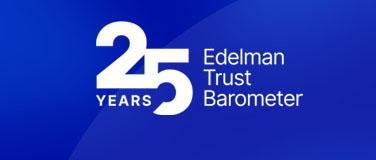The number of people with disabilities securing jobs is on the rise. In 2022, about 21 percent of people with a disability in the U.S. were employed, up from 19.1 percent in 2021, according to the U.S. Bureau of Labor Statistics (BLS). This is the highest the disabled employment rate has been since the U.S. began tracking these numbers in 2008.
With the disabled workforce growing in record numbers, due in large part to long COVID, a tight labor market, and the rise of remote work, so too is the need to build trust among disabled workers. According to a new special analysis of the 2023 Edelman Trust Barometer Special Report: Trust at Work, disabled employees are less trusting than their nondisabled counterparts. The good news for employers is that they hold the key to building trust among the community.
THE DISABILITY COMMUNITY IS LESS TRUSTING — PARTICULARLY DESKLESS WORKERS
Despite the prevalence of disabilities, studies have shown that people with disabilities are less likely to be employed and more likely to work fewer hours (source), earn lower incomes (source), and accumulate less wealth than those without (source). Our Trust at Work Disability analysis data shows this divide also extends to trust: Employees with disabilities are less trusting of their employers than their nondisabled counterparts (7-point difference), and even less trusting of institutions, such as business, NGOs, media and government. This lack of trust of both employers and institutions is even worse among deskless workers with disabilities.
But it’s not just trust in institutions where we see differences between workers with and without disabilities — we also see a difference in perceived DEI progress and increased burnout. Our data show workers with disabilities are:
- Less likely to see their employer driving meaningful progress on DEI initiatives (4-point difference)
- Less satisfied with how their employer is getting involved in social issues (7-point difference) and
- Feel less protected by their employer from burnout (9-point difference).
Similar to trust levels, there are even greater gaps between deskless workers with or without disabilities and desk workers with or without disabilities.
Workers with disabilities are also more willing to take things public: 1 in 2 employees with disabilities (or 50%) are willing to go public to push for change at work versus 33 percent of employees without disabilities. This staggering statistic suggests the disability community is highly perceptive of inauthenticity or when companies miss the mark.
THE KEY TO BUILDING TRUST LIES WITH THE EMPLOYER
It’s clear that disabled workers are in a vulnerable and ultimately lonely position at the periphery of their organizations, feeling distant from societal institutions. But there is hope. Even though they are less trusting than their nondisabled counterparts, employees with disabilities have more trust in their employers than they do the other institutions — suggesting employers may ultimately be the lifeline when it comes to earning trust with the disability community. Here's what it takes to for employers to effectively build and earn trust among the disabled community:
Take on a "nothing for us without us" mentality.
A common mantra among the disability community is “nothing for us without us,” which means actively involving people with disabilities in planning strategies and policies that affect their lives. This principle applies to improving and earning trust with the community: Include these people in decisions that impact how they work and operate.
Create an infrastructure that allows disabled voices to be heard.
Our data shows the disability community is highly attuned to injustice and willing to go public if they feel their voices aren’t heard. To help solve for this, create a stakeholder council, a hierarchy team, or formal support for manager advocacy that elevates disabled voices. Ensure these teams include people with disabilities to ensure their concerns are being represented and addressed.
Avoid "one size fits all" solutions by engaging employees with disabilities directly.
One of the beauties of the disability community is that no two disabilities are the same. Two people can have the “same” disability but face completely different barriers. That’s why, when speaking about or addressing the needs of disabled employees, its important employers don’t make assumptions. Rather, take the time to ask questions that help pinpoint barriers in the workplace, and use that feedback to identify solutions.
Address the needs of deskless workers with disabilities.
Data from the Trust at Work Disability analysis shows deskless workers, with or without disabilities, are the most vulnerable when it comes to trust, DEI in the workplace, and burnout. Rethinking the meaning of work and being intentional in how employers address DEI initiatives could help win back these workers.
Josh Galassi is a proud member of the disability community and an Account Supervisor on the Xbox Gaming for Everyone team at Assembly, where he specializes in disability and accessibility communications.
© ImageFlow — stock.adobe.com




